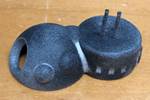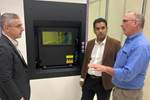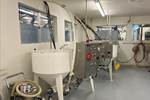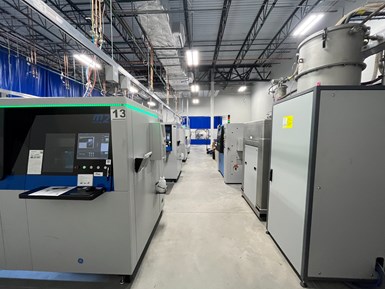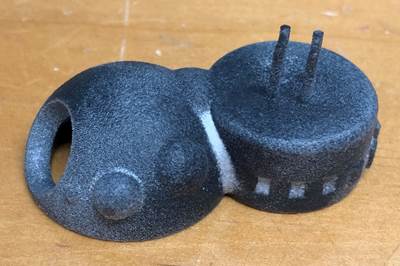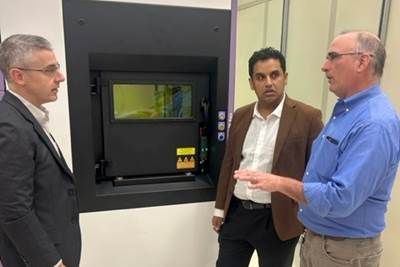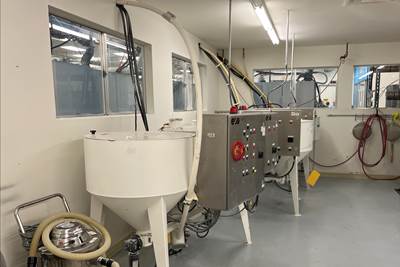Recently I had the opportunity to visit Protolabs’ new direct metal laser sintering (DMLS) facility in Raleigh, North Carolina, where the company continues to expand its additive offerings. The contract manufacturer has seen the increasing demand for additive over the course of a decade now.
I spoke with the company’s president and CEO, Robert Bodor and 3D printing applications engineer manager, Eric Utley to learn more about this long-term demand growth and the new facility, which was built from the ground up.
Protolabs’ new direct metal laser sintering (DMLS) facility opened its doors the first week of October 2023. Built from the ground up, this facility will accommodate the growing demand for metal additive.
The new site sits directly across from its predecessor, a facility that used to house all of the 3D printing technology at the Raleigh campus but now houses only the non-metal 3D printing capacity. The new DMLS facility is metal-focused, and Protolabs is in the process of moving these machines to their new 120,000-square-foot-home.
A Growing Portfolio
Protolabs began its manufacturing journey in 1999 with injection molding for plastic prototype parts. The company saw an opportunity in its development of automated software solutions to assist with short-run manufacturing by speeding order processing and workflow. It expanded beyond injection molding, opening facilities worldwide to offer additional services such as quick-turn CNC machining, and industrial-grade 3D printing. Its most notable new investment relates to the changing role of this last capability.
“Protolabs is continually excited by additive manufacturing and the opportunities found in this space. More and more we see AM’s potential for production parts,” Bodor says.
A Tale of Two Facilities
The new facility offers the Protolabs team necessary freedom in terms of facility design, workflow and functionality for increasing volume of metal AM work. Touring both facilities made clear how the newer one was built to respond to challenges seen in its predecessor.
As the original facility housed all available AM technologies, it was filled to the brim after about six years in existence. “This speaks a lot to the evolving nature of additive. New technologies, machines and support equipment are continually being discovered in this space,” Utley says.
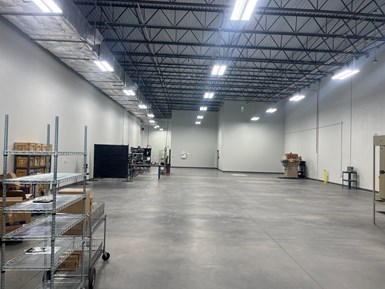
The new facility plans to gradually expand its metal additive manufacturing options to ensure long-term demand is successful. Purposefully empty space holds possibilities for new technologies to come.
That filling of the original facility space happened even though the capacity expansion was methodical. Every technology selection was evaluated to assure it met a variety of customers’ needs and would be long-lasting in terms of life span and relevance.
The expectation of similar growth, therefore, served as a motivator in the creation of the new facility. “Right now, the DMLS facility is purposefully starting out at about one-third of the way full,” Utley says.
DMLS Facility Opportunities
Out of the 120,000 square feet, 60,000 square feet (part of it unfilled) has been reserved for DMLS printers. Currently, there are 33 DMLS printers and counting with space to fit a further 91. Over 75 employees are dedicated to DMLS operations. The current DMLS machines are all from GE Additive. They include two X Line 2000R large format printers, 17 M2 machines, 12 smaller Mlab machines and two Mlab 200R machines.
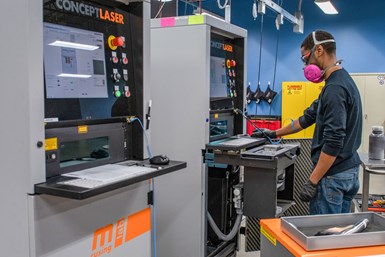
The image above depicts a pair of Mlabs DMLS 3D printers. Protolabs continues to move its metal printers from the old facility into the new. Photo credit: Protolabs
“We are able to generate about 80,000 to 100,000 printed parts monthly for a variety of customers,” Bodor says.
Throughout the new facility, electronic boards depict the progress of active projects. The open floor plan has clear divider curtains separating spaces. In the DMLS area, parts from different customers can be seen being printed at the same time, often on the same build plate (if they share compatible geometries) to save time and cost for each job.

This area of the new DMLS facility is where human-hand detailing is applied to parts that customers wish to further finish and customize.
The new facility also offers a variety of equally important support equipment to supplement the additive machines with postprocessing. Capability areas include an on-site CNC machine shop and an expansive materials and quality laboratory space (still being filled), with plans for a dimensional metrology unit.
Additionally, the facility offers postprocessing options such as bead blasting, painting, dying and human-hand detailing for customers wishing to further finish their parts.
Related Content
ActivArmor Casts and Splints Are Shifting to Point-of-Care 3D Printing
ActivArmor offers individualized, 3D printed casts and splints for various diagnoses. The company is in the process of shifting to point-of-care printing and aims to promote positive healing outcomes and improved hygienics with customized support devices.
Read More3D Printing with Plastic Pellets – What You Need to Know
A few 3D printers today are capable of working directly with resin pellets for feedstock. That brings extreme flexibility in material options, but also requires greater knowledge of how to best process any given resin. Here’s how FGF machine maker JuggerBot 3D addresses both the printing technology and the process know-how.
Read MoreHow Machining Makes AM Successful for Innovative 3D Manufacturing
Connections between metal 3D printing and CNC machining serve the Indiana manufacturer in many ways. One connection is customer conversations that resemble a machining job shop. Here is a look at a small company that has advanced quickly to become a thriving additive manufacturing part producer.
Read MoreThis Drone Bird with 3D Printed Parts Mimics a Peregrine Falcon: The Cool Parts Show #66
The Drone Bird Company has developed aircraft that mimic birds of prey to scare off problem birds. The drones feature 3D printed fuselages made by Parts on Demand from ALM materials.
Read MoreRead Next
6 Considerations When Launching an Additive Startup
Recent additive manufacturing (AM) startup owner, JP Kinerk, shares his experience by offering helpful advice for others just starting out in the additive realm.
Read MoreNew Zeda Additive Manufacturing Factory in Ohio Will Serve Medical, Military and Aerospace Production
Site providing laser powder bed fusion as well as machining and other postprocessing will open in late 2023, and will employ over 100. Chief technology officer Greg Morris sees economic and personnel advantages of serving different markets from a single AM facility.
Read MoreA Tour of The Stratasys Direct Manufacturing Facility
The company's Belton manufacturing site in Texas is growing to support its various 3D printing applications for mass production in industries such as automotive and aerospace.
Read More


